Advertisements
Advertisements
प्रश्न
(i) Explain with the help of a diagram the formation of depletion region and barrier potential in a pn junction.
उत्तर
(i) In a p−n junction, a p-type and an n-type material are joined together. The concentration of holes is higher in p-type material as compared to that in n-type material. Therefore, there is a concentration gradient between the p-type and n-type materials. As a result of this concentration gradient, holes move from p-side to n-side (p → n) by the process of diffusion. Similarly, electrons move from n-side to p-side (n → p).
As the holes diffuse from p-side, they leave ionised spaces (negatively charged) on p-side near the junction. These ionised spaces are immobile. Hence, a negative space-charge region is formed on the p-side near the junction. Similarly, a positive space-charge region is formed on the n-side. These two space-charge regions on either sides of the junction constitute what is called a depletion layer.
Since the n-side loses electrons and p-side gains electrons, a potential difference is developed across the junction of the two regions. This potential difference tends to oppose further motion of electrons from the n-region into the p-region. The same happens for holes too. The reverse polarity of this potential opposes further flow of carriers and is thus called the barrier potential
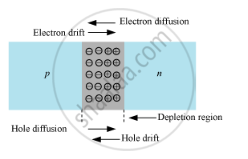
संबंधित प्रश्न
When a forward bias is applied to a p-n junction, it ______.
Draw a labelled diagram of a full wave rectifier. Show how output voltage varies with time if the input voltage is a sinusoidal voltage.
In Figure, Vo is the potential barrier across a p-n junction, when no battery is connected across the junction ______.
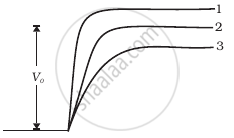
In the circuit shown in figure, if the diode forward voltage drop is 0.3 V, the voltage difference between A and B is ______.

Figure shows the transfer characteristics of a base biased CE transistor. Which of the following statements are true?

At Vi = 0.4 V, transistor is in active state.
At Vi = 1 V, it can be used as an amplifier.
At Vi = 0.5 V, it can be used as a switch turned off.
At Vi = 2.5 V, it can be used as a switch turned on.
Draw V-I characteristics of a p-n Junction diode.
Answer the following giving reasons:
A p-n junction diode is damaged by a strong current.
Describe briefly the following term:
breakdown voltage in reverse biasing
Read the following paragraph and answer the questions that follow.
| A semiconductor diode is basically a pn junction with metallic contacts provided at the ends for the application of an external voltage. It is a two-terminal device. When an external voltage is applied across a semiconductor diode such that the p-side is connected to the positive terminal of the battery and the n-side to the negative terminal, it is said to be forward-biased. When an external voltage is applied across the diode such that the n-side is positive and the p-side is negative, it is said to be reverse-biased. An ideal diode is one whose resistance in forward biasing is zero and the resistance is infinite in reverse biasing. When the diode is forward biased, it is found that beyond forward voltage called knee voltage, the conductivity is very high. When the biasing voltage is more than the knee voltage the potential barrier is overcome and the current increases rapidly with an increase in forward voltage. When the diode is reverse biased, the reverse bias voltage produces a very small current of about a few microamperes which almost remains constant with bias. This small current is a reverse saturation current. |
- In the given figure, a diode D is connected to an external resistance R = 100 Ω and an emf of 3.5 V. If the barrier potential developed across the diode is 0.5 V, the current in the circuit will be:

(a) 40 mA
(b) 20 mA
(c) 35 mA
(d) 30 mA - In which of the following figures, the pn diode is reverse biased?
(a)
(b)
(c)
(d)
- Based on the V-I characteristics of the diode, we can classify the diode as:
(a) bilateral device
(b) ohmic device
(c) non-ohmic device
(d) passive element
OR
Two identical PN junctions can be connected in series by three different methods as shown in the figure. If the potential difference in the junctions is the same, then the correct connections will be:
(a) in the circuits (1) and (2)
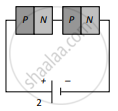
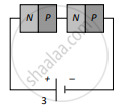
(b) in the circuits (2) and (3)
(c) in the circuits (1) and (3)
(d) only in the circuit (1) 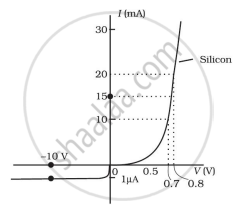
The V-I characteristic of a diode is shown in the figure. The ratio of the resistance of the diode at I = 15 mA to the resistance at V = -10 V is
(a) 100
(b) 106
(c) 10
(d) 10-6
Draw a labelled characteristic curve (l-V graph) for a semiconductor diode during forward bias.
